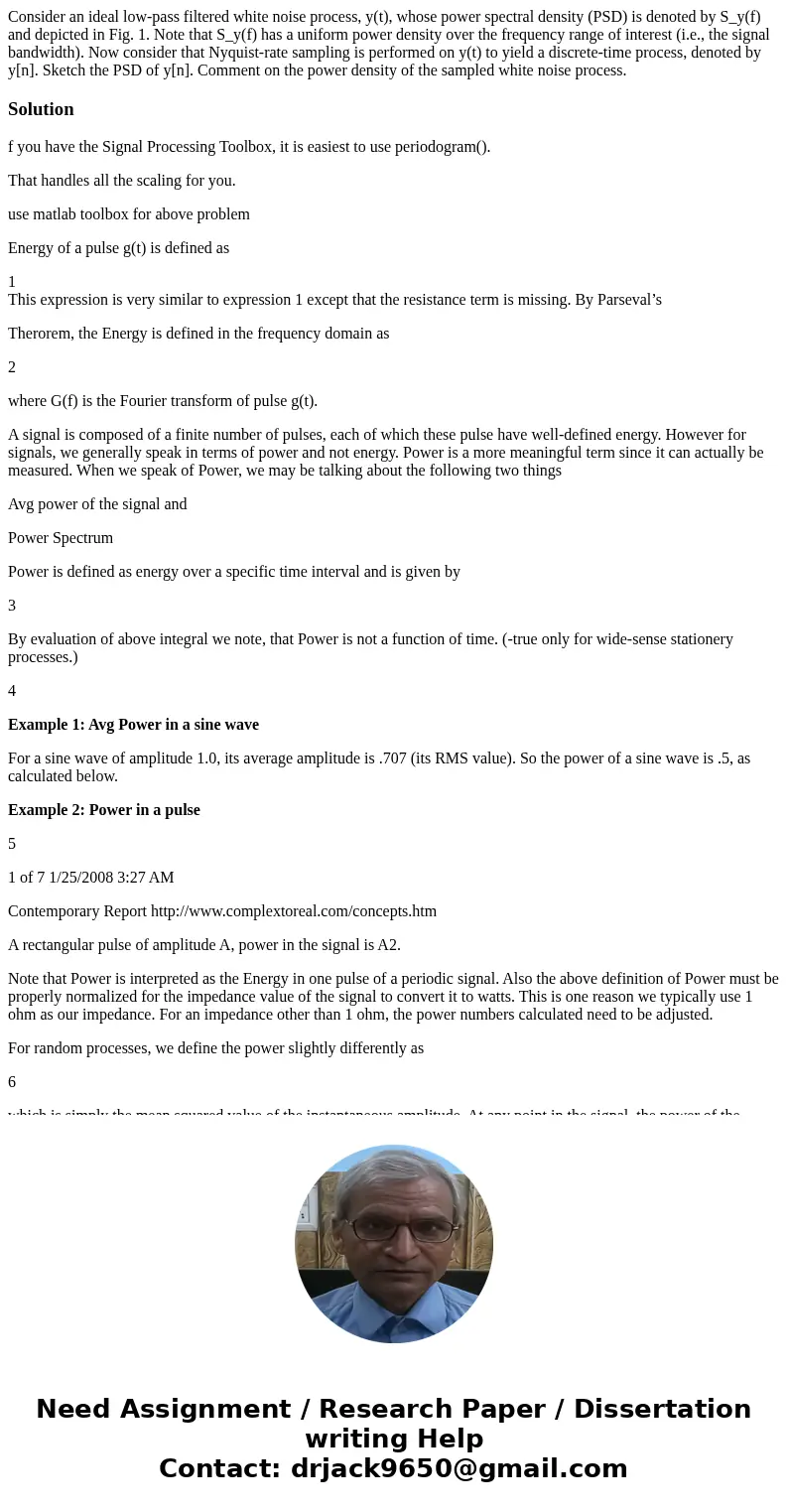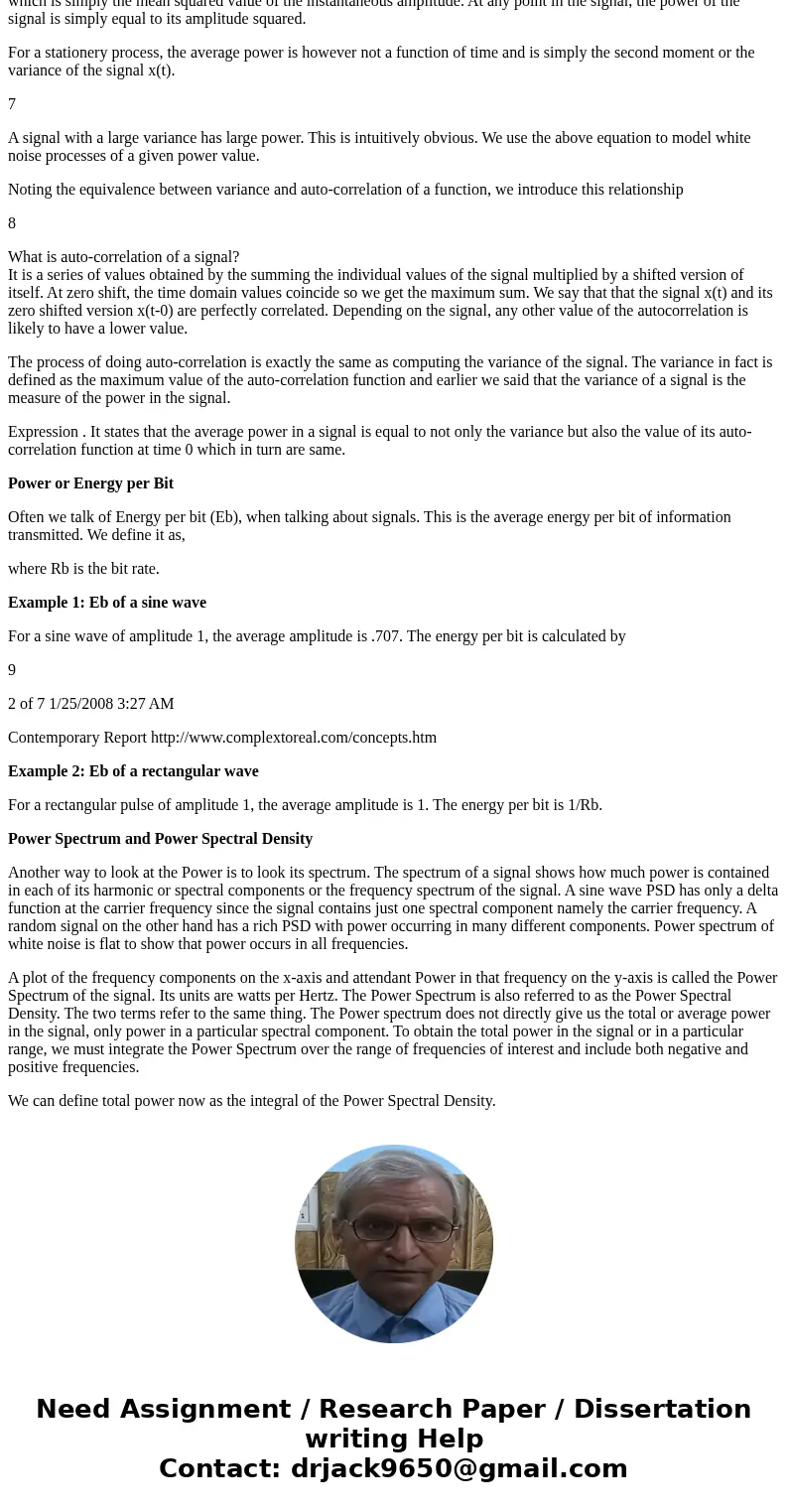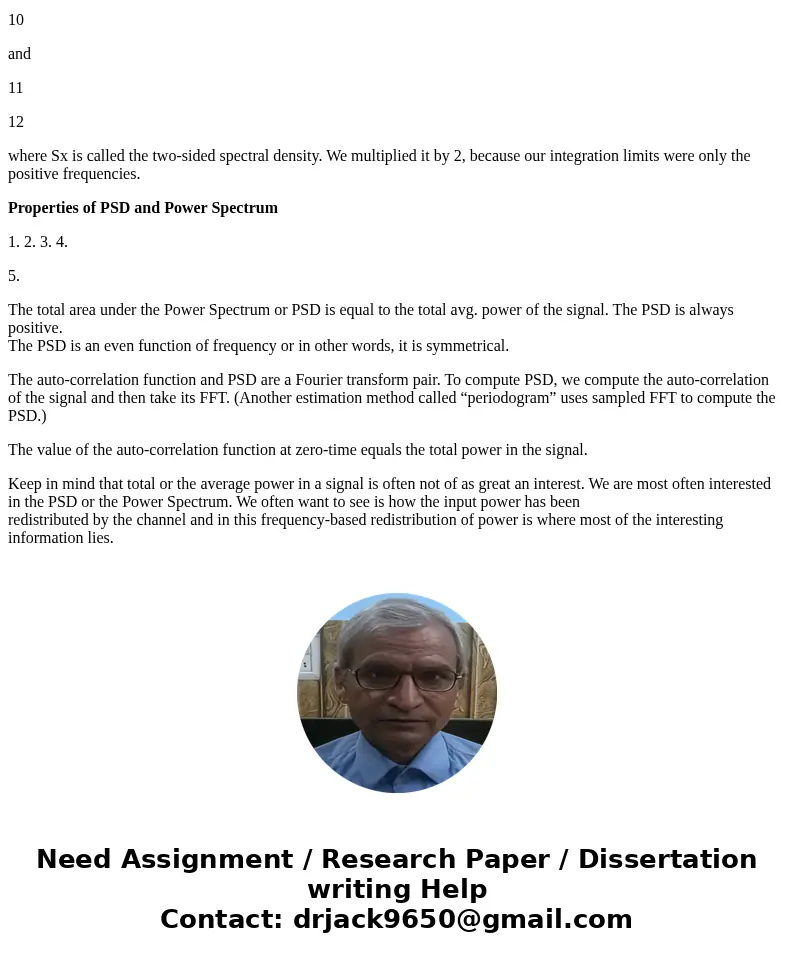Consider an ideal lowpass filtered white noise process yt wh
Solution
f you have the Signal Processing Toolbox, it is easiest to use periodogram().
That handles all the scaling for you.
use matlab toolbox for above problem
Energy of a pulse g(t) is defined as
1
This expression is very similar to expression 1 except that the resistance term is missing. By Parseval’s
Therorem, the Energy is defined in the frequency domain as
2
where G(f) is the Fourier transform of pulse g(t).
A signal is composed of a finite number of pulses, each of which these pulse have well-defined energy. However for signals, we generally speak in terms of power and not energy. Power is a more meaningful term since it can actually be measured. When we speak of Power, we may be talking about the following two things
Avg power of the signal and
Power Spectrum
Power is defined as energy over a specific time interval and is given by
3
By evaluation of above integral we note, that Power is not a function of time. (-true only for wide-sense stationery processes.)
4
Example 1: Avg Power in a sine wave
For a sine wave of amplitude 1.0, its average amplitude is .707 (its RMS value). So the power of a sine wave is .5, as calculated below.
Example 2: Power in a pulse
5
1 of 7 1/25/2008 3:27 AM
Contemporary Report http://www.complextoreal.com/concepts.htm
A rectangular pulse of amplitude A, power in the signal is A2.
Note that Power is interpreted as the Energy in one pulse of a periodic signal. Also the above definition of Power must be properly normalized for the impedance value of the signal to convert it to watts. This is one reason we typically use 1 ohm as our impedance. For an impedance other than 1 ohm, the power numbers calculated need to be adjusted.
For random processes, we define the power slightly differently as
6
which is simply the mean squared value of the instantaneous amplitude. At any point in the signal, the power of the signal is simply equal to its amplitude squared.
For a stationery process, the average power is however not a function of time and is simply the second moment or the variance of the signal x(t).
7
A signal with a large variance has large power. This is intuitively obvious. We use the above equation to model white noise processes of a given power value.
Noting the equivalence between variance and auto-correlation of a function, we introduce this relationship
8
What is auto-correlation of a signal?
It is a series of values obtained by the summing the individual values of the signal multiplied by a shifted version of itself. At zero shift, the time domain values coincide so we get the maximum sum. We say that that the signal x(t) and its zero shifted version x(t-0) are perfectly correlated. Depending on the signal, any other value of the autocorrelation is likely to have a lower value.
The process of doing auto-correlation is exactly the same as computing the variance of the signal. The variance in fact is defined as the maximum value of the auto-correlation function and earlier we said that the variance of a signal is the measure of the power in the signal.
Expression . It states that the average power in a signal is equal to not only the variance but also the value of its auto-correlation function at time 0 which in turn are same.
Power or Energy per Bit
Often we talk of Energy per bit (Eb), when talking about signals. This is the average energy per bit of information transmitted. We define it as,
where Rb is the bit rate.
Example 1: Eb of a sine wave
For a sine wave of amplitude 1, the average amplitude is .707. The energy per bit is calculated by
9
2 of 7 1/25/2008 3:27 AM
Contemporary Report http://www.complextoreal.com/concepts.htm
Example 2: Eb of a rectangular wave
For a rectangular pulse of amplitude 1, the average amplitude is 1. The energy per bit is 1/Rb.
Power Spectrum and Power Spectral Density
Another way to look at the Power is to look its spectrum. The spectrum of a signal shows how much power is contained in each of its harmonic or spectral components or the frequency spectrum of the signal. A sine wave PSD has only a delta function at the carrier frequency since the signal contains just one spectral component namely the carrier frequency. A random signal on the other hand has a rich PSD with power occurring in many different components. Power spectrum of white noise is flat to show that power occurs in all frequencies.
A plot of the frequency components on the x-axis and attendant Power in that frequency on the y-axis is called the Power Spectrum of the signal. Its units are watts per Hertz. The Power Spectrum is also referred to as the Power Spectral Density. The two terms refer to the same thing. The Power spectrum does not directly give us the total or average power in the signal, only power in a particular spectral component. To obtain the total power in the signal or in a particular range, we must integrate the Power Spectrum over the range of frequencies of interest and include both negative and positive frequencies.
We can define total power now as the integral of the Power Spectral Density.
10
and
11
12
where Sx is called the two-sided spectral density. We multiplied it by 2, because our integration limits were only the positive frequencies.
Properties of PSD and Power Spectrum
1. 2. 3. 4.
5.
The total area under the Power Spectrum or PSD is equal to the total avg. power of the signal. The PSD is always positive.
The PSD is an even function of frequency or in other words, it is symmetrical.
The auto-correlation function and PSD are a Fourier transform pair. To compute PSD, we compute the auto-correlation of the signal and then take its FFT. (Another estimation method called “periodogram” uses sampled FFT to compute the PSD.)
The value of the auto-correlation function at zero-time equals the total power in the signal.
Keep in mind that total or the average power in a signal is often not of as great an interest. We are most often interested in the PSD or the Power Spectrum. We often want to see is how the input power has been
redistributed by the channel and in this frequency-based redistribution of power is where most of the interesting information lies.



 Homework Sourse
Homework Sourse